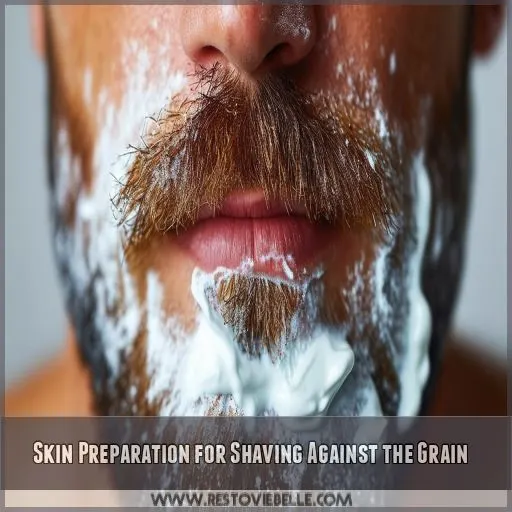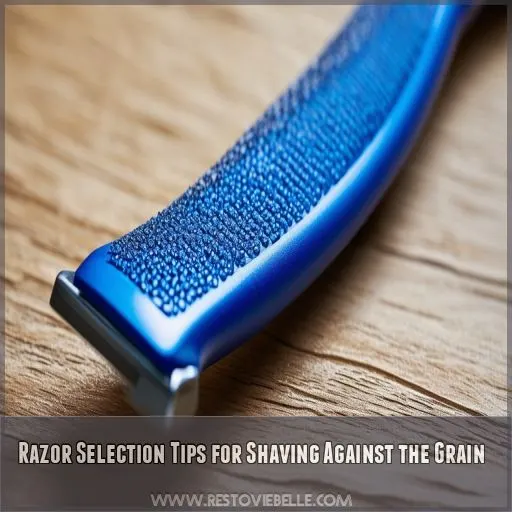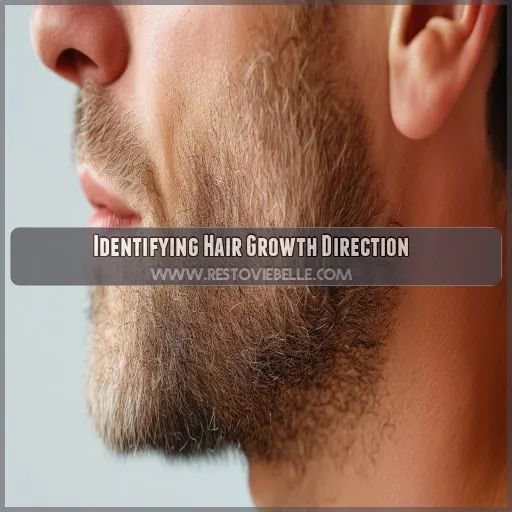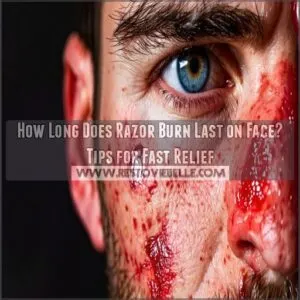This site is supported by our readers. We may earn a commission, at no cost to you, if you purchase through links.
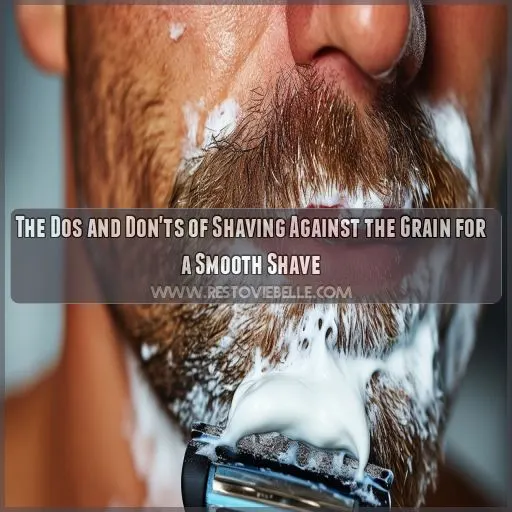 Mastering the technique of shaving against the grain can provide an unusually smooth shave; however, this requires precision. This tricky method—for careful reversal of natural hair growth—will keep one free from the irritation of stubble and give him a closer and cleaner cut.
Mastering the technique of shaving against the grain can provide an unusually smooth shave; however, this requires precision. This tricky method—for careful reversal of natural hair growth—will keep one free from the irritation of stubble and give him a closer and cleaner cut.
Still, it has risks like irritation and ingrown hairs that come along with it. To get the best and smoothest finish without damaging your skin, you must know the do’s and dont’s of this advanced shaving technique. Learn how to unlock that perfect shave.
Table Of Contents
- Key Takeaways
- Benefits and Risks of Shaving Against the Grain
- Skin Preparation for Shaving Against the Grain
- Razor Selection Tips for Shaving Against the Grain
- Identifying Hair Growth Direction
- Techniques for Shaving Against the Grain
- Managing Irritation and Ingrown Hairs
- Aftercare for Shaving Against the Grain
- Who Should Avoid Shaving Against the Grain?
- Frequently Asked Questions (FAQs)
- Is it bad to shave against the grain?
- Should you shave your pubic hair against the grain?
- Does shaving against the grain make hair thicker?
- What happens if you shave in the wrong direction?
- How should I store my razor?
- Can I shave against the grain on dry skin?
- Is it safe to reuse shaving gel?
- How often should I change my razor blade?
- What are common myths about shaving?
- Conclusion
Key Takeaways
- Shaving against the grain can give you a closer finish, but be careful not to cut yourself! It’s a bit like walking a tightrope – you can get to the other side faster, but there’s a higher chance of falling.
- If you’ve got sensitive skin, shaving against the grain is like poking a sleeping bear – it’s probably not going to end well. Stick to shaving with or across the grain instead.
- Before you shave against the grain, make sure you prep your skin like a pro. Warm water, exfoliation, and shaving cream are your secret weapons for a smooth and irritation-free shave.
- After you’ve shaved against the grain, treat your skin like royalty. Cool water, moisturizer, and aftershave balm will help soothe any irritation and keep your skin feeling fresh and fabulous.
Benefits and Risks of Shaving Against the Grain
Shaving against the grain can provide a closer shave, but it also carries higher risks of skin irritation and ingrown hairs. While this technique requires more precision, it may not be suitable for all skin types or hair textures.
Closer Shave Benefits
When you shave against the grain, you’ll enjoy a closer shave, achieving a super-smooth finish. Benefits include:
- Smooth shave: Achieve an exceptionally smooth finish.
- Close shave: Reduces the need for frequent shaving.
- Time considerations: Spend less time on daily grooming.
- Detailed precision: Tackle stubborn areas for a polished look.
Remember to align with hair direction for best results.
Irritation And Ingrown Risks
While shaving against the grain can provide a closer shave, it also carries risks of skin irritation and ingrown hairs. Beginners should exercise caution, as improper technique can lead to painful bumps and sensitivity. Ultimately, your personal preference and skin type should guide your shaving approach – expert guidance is advised to minimize potential issues.
| Potential Risks | Causes | Mitigation Strategies |
|---|---|---|
| Skin Irritation | Aggressive shaving against the grain | Use a gentle razor, shave with the grain first |
| Ingrown Hairs | Cutting hair below skin level | Exfoliate regularly, avoid too-close shaves |
| Razor Bumps | Friction and irritation from shaving | Apply soothing aftershave balm, avoid multiple passes |
| Sensitivity | Repeated shaving against the grain | Adjust technique based on your skin type and facial hair |
Shaving Technique Precision
Using the pass method, follow the hair’s direction carefully. Start by shaving with the grain, then reapply gel and shave across, finishing against the grain for precision. Use a warm washcloth to soften the hairs. Opt for the right blade choice and use your hand or a card to determine hair growth direction. Avoid too much pressure.
Skin Preparation for Shaving Against the Grain
Showering w warm prepares the skin to shave against the grain. Warmth in water softens the hair and opens up the pores. Exfoliate well to remove dead skin cells that may lead to ingrown hairs later. You can use a gentle Facial scrub for this purpose.
Soak the part to be shaved in warm water for at least three minutes. Apply plenty of foam or shaving gel to protect the skin from damage and reduce friction. Shave in short, careful strokes, and rinse blades often to keeps them clean.
Follow up with an aftershave moisturizer to cool and hydrate your skin. Proper preparation prevents irritation and assures a smoother, closer shave for that ultimate feeling of control over your grooming ritual.
Razor Selection Tips for Shaving Against the Grain
When shaving against the grain, opt for a high-quality razor with sharp blades to minimize irritation. An electric razor can offer an easier and more comfortable experience for those with sensitive skin.
Blade Type Preference
If you’re going to shave against the grain, use a razor with quality blades designed for your skin type. They should constitute tough materials that remain sharp, like stainless steel.
Most of all, the angle of the blade is very critical since the more perpendicular it becomes, the closer the shave: the closer that will compel one to be with the razor while shaving.
Look for blades that give a smooth and comfortable shave.
Razor Sharpness Importance
Razor sharpness is everything, and in an against-the-grain shave, it lets one cut through that stubble with ease, reducing irritation and providing a close shave.
Blade angle: 30° for best results (Source).
- Pair it with quality shaving soap to protect your skin (Source).
- Avoid aftershaves that are alcohol based for lesser instances of irritation immediately after shaving (Source).
Benefits Of Electric Razors
Consider electric razor models like cordless vs corded razors or rotary vs foil razors. Electric razors offer convenience, especially for travel. Opt for self-cleaning razors for maintenance ease. Remember, the dos and don’ts of shaving against the grain apply here too. Use a beard trimmer and quality shaving products, and always wash your face before and after shaving.
Identifying Hair Growth Direction
Knowing the direction of your hair growth is important when a person is shaving against the grain. Just gently rub your hand across your face initially; you’ll feel areas where the hair bristles up, telling you which way the grain is going. In those spots, you’ll want to shave upwards with the grain.
On the other hand, where it lays flat, you can shave against the grain for an even closer shave. Notice the different patterns of grains on your face, as this differs quite a bit from one area of the face to another.
In this facial mapping, you’ll also be able to move around while shaving and reduce irritation, especially if you have very sensitive skin. For beginners, it’s always better to err on the side of caution and stick with shaving in the direction of the grain until you get a feel for it.
Techniques for Shaving Against the Grain
When shaving against the grain, you’ll want to take your time and follow a methodical approach. Begin by shaving with the grain first, then reapply a generous amount of shaving gel or foam. This helps lubricate the skin and soften the hair for subsequent passes.
For the second pass, shave across the grain, using short, gentle strokes. Be sure to rinse your blade frequently to prevent clogging. If needed, you can then shave against the grain, but do so cautiously and with light pressure. Exfoliating prior to shaving helps remove dead skin cells and allows the blade to glide more smoothly. Remember, a sharp, clean razor is essential for a close, comfortable shave against the grain.
Managing Irritation and Ingrown Hairs
Let’s move away from technique and into managing irritation and ingrown hairs, which seem to always be an unhappy consequence of razoring the grain. Here’s how to take care of your skin:
- Exfoliate regularly: Scrub out all those excess dead skin cells to prevent razor bumps and ingrown hairs.
- Use balms after shave: Soothing lotions help reduce shaving irritation, thereby keeping the skin more hydrated.
- Warm washcloth: Apply a warm one over razor bumps to soothe inflammation and discomfort.
More ways to reduce ingrown hairs are by making gentle, controlled strokes and not shaving too snugly. Remember, baby-smooth isn’t worth the pain. Keep it up in a routine and pay attention to your skin’s reaction. That proactive move keeps your face in tip-top condition and gives you back control in your grooming experience.
Aftercare for Shaving Against the Grain
Following the shave against the grain, it’s very essential to follow the proper aftercare actions that help placate your skin from the irritation. Begin by splashing off in cool water to settle down any redness or inflammation.
Pat dry your skin using a soft, clean towel gently without much rubbing. Make use of warm compresses for some minutes; afterward, apply a moisturizing aftershave balm or lotion in order to hydrate and nourish your skin.
Harsh soaps will dry the skin out, as they have a tendency to remove its natural oils, allowing further irritation to the razor burn. Instead, opt for gentle fragrance-free moisturizers that soothe inflamed skin and may help in the prevention of razor burn.
This extra attention taken after shaving results in a smoother, more comfortable finish.
Who Should Avoid Shaving Against the Grain?
Right after pampering your skin post-shave, it’s very important to consider when shaving against the grain is the right thing to do for you. It’s not for everyone; some people should steer way clear of this to avoid any complication.
- Coarse or Curly Hair
These hair types can get worse with against-the-grain shaving and are prone to ingrown hairs.
- Sensitive Skin
- If you experience irritation regularly, shaving against the grain may increase redness and irritation.
- Beginners
If you shave against the grain and your technique isn’t so good, then you might nick or cut your skin, which leads to irritation. Instead, learn how to shave well with the grain of hair first.
Understanding these factors helps you make an informed choice, ensuring your shave is both smooth and safe.
Frequently Asked Questions (FAQs)
Is it bad to shave against the grain?
Shaving against the grain can give you a closer shave but often leads to irritation, razor bumps, and ingrown hairs. It’s best for experienced shavers; beginners should stick to shaving with or across the grain.
Should you shave your pubic hair against the grain?
It’s best not to shave your pubic hair against the grain. Doing so can cause irritation, razor bumps, and ingrown hairs. Always shave with the grain or across for smoother, less irritating results.
Does shaving against the grain make hair thicker?
Shaving against the grain doesn’t make hair thicker. It’s a myth. However, it can cause irritation and ingrown hairs. The hair may feel coarser due to the sharp cut of the razor.
What happens if you shave in the wrong direction?
Shave against the grain, and you’ll be in for a rude awakening – razor burn, irritation, and even ingrown hairs. Play it safe, my friend, and shave with the grain for a smooth, comfortable shave.
How should I store my razor?
Store your razor in a dry place to prevent rust. Avoid keeping it in the shower. Use a razor stand or holder to keep the blades away from wet surfaces, ensuring they stay sharp and hygienic.
Can I shave against the grain on dry skin?
Shaving against the grain on dry skin is a recipe for disaster. You’ll risk major irritation, cuts, and razor burn. Always hydrate your skin and apply shave gel to soften hairs and protect yourself.
Is it safe to reuse shaving gel?
It’s generally not recommended to reuse shaving gel, as it can harbor bacteria and lose its lubricating properties. For the best shave, use a fresh application each time.
How often should I change my razor blade?
Although replacing the razor blade seems like an everyman task, let it be regarded as recharging a battery: it should be done every 5-7 shaves to have a close and smooth shave and avoid such annoying things as irritation or even infections from too-dull a blade.
What are common myths about shaving?
Myths about shaving? Don’t believe the hype – shaving against the grain isn’t always a no-go. With the right technique, it can deliver a closer shave. Just take it slow and listen to your skin.
Conclusion
Think of shaving against the grain as a double-edged sword. With the right information at hand, you’ll be much closer to a smoother shave. Noting all the dos and don’ts regarding shaving against the grain will be very important in keeping away from common mistakes: irritation and ingrown hairs.
Always make sure to prepare your skin properly, select the proper razor, apply precise techniques, and look after the skin afterwards. This method isn’t for everyone, but it could redefine how one shaves daily.


